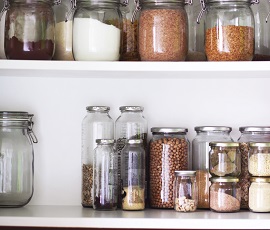Zoe Bingley-Pullin: Meal Planning Made Simple – Just 5 Minutes Per Week

There are so many benefits to meal planning, it’s a wonder that more people don’t do it. I have found that some are reluctant to give it a go as they think it’s too hard or they doubt themselves in the kitchen. Others find excuses like “I don’t know what I’ll feel like eating on Thursday” or they try it but don’t keep it going long term. In this article I want to show you just how easy it can be. Once you’ve got the hang of it, I promise, you will be confidently meal planning in just 5 minutes per week!
Why bother?
The benefits of meal planning
The biggest benefit of meal planning is that you’re in control. This is particularly important if trying to manage your weight, stay on track with a healthy eating regime or feed a family. Meal planning ensures you eat better as your meal blueprint in set and your fridge is filled accordingly. There are fewer opportunities for poor choices such as last minute take aways or unhealthy snacks. In this large French scientific study, meal planning was associated with healthier eating and less obesity.
Other advantages of meal planning are that you can reduce your stress as food becomes one less thing to worry about. You’ll save time and save money, as you shop once for the week, buy only what you need and gain efficiency in cooking to your set plan. You’ll definitely eat more variety and waste less this way too. Are you shocked to discover that Australians waste 1 in every 5 bags of groceries they buy? And lastly, meal planning will mean fewer arguments, as the food is already agreed upon and documented!
How to meal plan in 7 easy steps
So now I’ve convinced you on why you should do it, I’m going to show you the step by step of how to do it.
1. Set aside some time one day a week and diarise it so you remember. If you’ve never done this before, it may initially take you 15 minutes but in no time you’ll be meal planning in just 5 minutes per week. I like to come up with meal planning ideas on a Saturday morning as I’m not rushed and have the energy to think. Leaving meal planning until Sunday night is not ideal as it’s all too easy to postpone!
2. Ask for input. If you have a partner or family, ask them for suggestions. Meal planning is more successful if you have buy-in. Firstly make sure that their requests meet with your approval in terms of nutrition (crumbed fish fillets may be ok as long as they are teamed with a big serve of veges or salad). Perhaps allow yourself a splurge meal once every week or fortnight? And if one family member gets their favourite dish this week, rotate to someone else the next.
3. Check the calendar. Work out what commitments you and the family have for the week ahead and if that impacts who will need to be fed on any particular night.
4. Keep it simple & stay within your capabilities. This is critical, especially if you’re new to it or not a whiz in the kitchen. Meal planning doesn’t have to mean fine dining – healthy choices can be meat and 3 veg, a mixed leaf salad with a can of tuna on top, or a mushroom and cheese omelette. It’s also fine to rely on your standard repertoire of dishes from week to week. Eating a broad range of healthy fruit, veg, grains, nuts and legumes is important for our overall health though, so be sure to try to mix things up or challenge yourself to dip into a recipe book from time to time.
5. Create your meal plan. This can be a piece of paper, a computer printout or you can utilise some of the pre-designed templates found on the web. Slot in your agreed meals for each day of the week, taking into consideration the days you have time to cook and other nights that may call for leftovers or a healthy Dietlicious meal from the freezer.
6. Generate your shopping list to match. Write a shopping list based on your meal outline above, and what else you’ll need for breakfasts and lunches.
7. Advertise your meal plan. Put your weekly meal plan on the fridge or family noticeboard and you’ll never again be asked that annoying question, ‘What’s for dinner?’! Dinner disputes will be a thing of the past.
Other time & money-saving tips for meal planning success
If a healthy lifestyle is your goal, then the old adage applies, “if you fail to plan, then you plan to fail”. Without a meal plan in place, it’s so easy to fall off the wagon. Here are some of my other time-saving tips to help you make meal planning an easy part of your week.
- Reuse your meal plans. This is my best tip for reducing meal planning to under 5 minutes. If you’ve stored your meal plans on a computer or in a paper file, you can reuse them at any time, with or without tweaks.
- Check your fridge and pantry first; you may be able to use what you have instead of buying more.
- Consider snapping up specials at the supermarket and incorporating those ingredients in your following week’s meal plan.
- When you cook, make double batches and save half for later in the week or freeze it for use in the future.
- Everyone needs to fall back on a quick option sometimes. I love how the healthy frozen meals from Dietlicious can magically appear from the freezer and be on the table in 10 minutes, when I have no time or inclination to cook! Work some convenience into your meal plan so you know what to order ahead of time and you’ll never be caught out hungry.
- Try online meal planning idea tools(there’s a tonne of them out there), templates and shopping lists as these may make the experience more fun for you and save you time as it keeps your previous versions. If you buy groceries online, save your shopping lists for quick reorders.
- Try planning ahead for a fortnight instead of a week; this can save you even more time.
- Once you’ve mastered the dinner meal plan, you can extend your plan to encompass other meals and snacks too.
- Life doesn’t always go to plan, so your meal plan needs to be adaptable. Just push everything back by a day or reach for something quick in your freezer to readjust.
Still not sure where to start? Try cheating!
Are you too afraid to try meal planning as you think it’s complicated, you can’t think of enough healthy meals to fill a whole week or you just lack confidence? My suggestion is to take a look at other people’s meal plans – there’s no harm in copying!
Subscribe to my newsletter to get my 7 Day Meal Plan that outlines a healthy menu of breakfasts, lunches, dinners and snacks. You can also take a look at the huge variety of Dietlicious meal plans – broken up into 1200, 1500 and 1800 calories per day, depending on what your overall weight loss and healthy eating goals are. Sampling a plan like these is a sure-fire way to get you eating better and starting to lose weight and there’s no shame in that! It will also open your eyes to what is an appropriate portion size and show you about variety and good nutrition.











